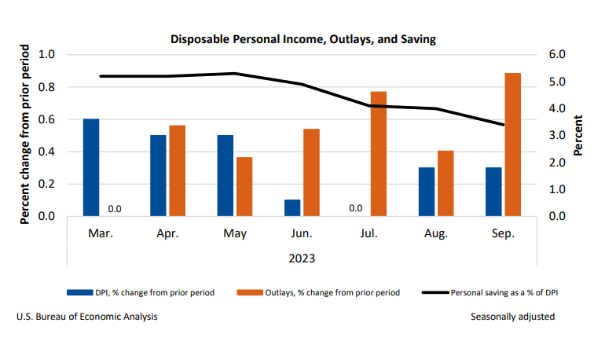
KPI – November 2023: The Brief
KPI – November 2023: State of the Economy
KPI – November 2023: State of Manufacturing
KPI – November 2023: State of Business – Automotive Industry
Below is a synopsis of consumer confidence, sentiment and income/spending trends.
The Conference Board Consumer Confidence Index declined moderately to 102.6 (1985=100) in October, down from an upwardly revised 104.3 in September. The Present Situation Index–based on consumers’ assessment of current business and labor market conditions–declined to 143.1 (1985=100) from 146.2.
Meanwhile, the Expectations Index–based on consumers’ short-term outlook for income, business and labor market conditions–decreased to 75.6 (1985=100) after declining to 76.4 a month prior.
The Expectations index remains below 80–a level which historically signals a recession within the next year. According to The Conference Board, consumer fears associated with an impending recession are elevated–consistent with the short and shallow economic contraction anticipated during the first half of 2024.

“Consumer confidence fell again in October 2023, marking three consecutive months of decline,” says Dana Peterson, chief economist at The Conference Board. “Write-in responses showed that consumers continued to be preoccupied with rising prices in general, and for grocery and gasoline prices in particular. Consumers also expressed concerns about the political situation and higher interest rates. Worries around war/conflicts also rose, amid the recent turmoil in the Middle East.”
Peterson says family finances remain “buoyant in the face of elevated inflation,” with consumers concerned about economic uncertainty, including runaway costs, stock prices, rising rates and war. In fact, more than two-thirds of consumers state a recession is “somewhat” or “very likely.”
According to recent data, the pullback in consumer confidence was evident across householders aged 35 and up, and not limited to any single income group.

Caption: The chart evaluates the historical context for this index as a coincident indicator of the economy. Toward this end, Advisor Perspectives highlighted recessions and included GDP. To put today’s report into the larger historical context since its beginning in 1978, consumer sentiment is 28.9% below its average reading (arithmetic mean) of 85.0 and 28% below its geometric mean of 83.9. The current index level is at the 4th percentile of the 551 monthly data points in this series. This indicator is somewhat volatile, with a 3.1-point absolute average monthly change. The latest data point, for example, posted a 3.4-point decrease month-over-month.
Similarly, the University of Michigan Survey of Consumers—a survey consisting of approximately 50 core questions covering consumers’ assessments of their personal financial situation, buying attitudes and overall economic conditions—dropped to 63.8 in October, a 5% month-over-month decline. November preliminary data projects a sharp downward trend to 60.4.
Important Takeaways, Courtesy of Survey of Consumers:
- Year-ahead inflation expectations inched up to 4.4%, indicating that the large increase between September’s 3.2% reading and October’s 4.2% reading was not a fluke.
- Long-run inflation expectations also rose, from 3% last month to 3.2% this month, the highest reading since 2011.
- Gas price expectations, both over the short and long run, climbed to their highest readings this year.
CONSUMER INCOME & SPENDING
According to the U.S. Bureau of Economic Analysis (BEA), in September 2023 personal income increased $77.8 billion (0.3% at a monthly rate), while disposable personal income–personal income less personal current taxes–increased $56.1 billion (0.3%).
In addition, personal outlays–the sum of personal consumption expenditures, personal interest payments and personal current transfer payments–increased $175.1 billion (0.9%). Personal saving registered $687.7 billion and the personal saving rate–personal saving as a percentage of disposable personal income–was 3.4% in September.

IMPORTANT TAKEAWAYS, COURTESY OF BEA:
- In September, consumer spending increased $138.7 billion (0.7%). Within services, the largest contributors to the increase included services (led by international travel), housing and utilities, health care and transportation services (led by air transportation). Within goods, the largest contributors to the increase included other nondurable goods (led by prescription drugs), as well as motor vehicles and parts (led by new light trucks). A decrease in gasoline and other energy goods (led by motor vehicle fuels, lubricants and fluids) helped to partly offset the increases.
- The PCE price index increased 0.4% compared to last month and 3.4% year-over-year. Prices for goods increased 0.9%, while services increased 4.7%. Food prices increased 2.7%, with energy costs holding steady. Excluding food and energy, the PCE price index increased 3.7% year-over-year.



